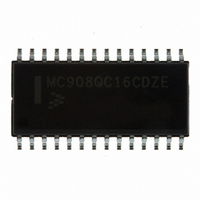MC908QC16CDZE Freescale Semiconductor, MC908QC16CDZE Datasheet - Page 210

MC908QC16CDZE
Manufacturer Part Number
MC908QC16CDZE
Description
IC MCU 8BIT 16K FLASH 28-SOIC
Manufacturer
Freescale Semiconductor
Series
HC08r
Specifications of MC908QC16CDZE
Core Processor
HC08
Core Size
8-Bit
Speed
8MHz
Connectivity
SCI, SPI
Peripherals
LVD, POR, PWM
Number Of I /o
24
Program Memory Size
16KB (16K x 8)
Program Memory Type
FLASH
Ram Size
512 x 8
Voltage - Supply (vcc/vdd)
3 V ~ 5.5 V
Data Converters
A/D 10x10b
Oscillator Type
Internal
Operating Temperature
-40°C ~ 85°C
Package / Case
28-SOIC (7.5mm Width)
Processor Series
HC08QC
Core
HC08
Data Bus Width
8 bit
Data Ram Size
512 B
Interface Type
ESCI/SPI
Maximum Clock Frequency
8 MHz
Number Of Programmable I/os
26
Number Of Timers
6
Maximum Operating Temperature
+ 85 C
Mounting Style
SMD/SMT
Development Tools By Supplier
FSICEBASE, M68CBL05AE, DEMO908QB8, DEMO908QC16
Minimum Operating Temperature
- 40 C
On-chip Adc
10-ch x 10-bit
For Use With
DEMO908QC16 - BOARD DEMO FOR MC908QC16
Lead Free Status / RoHS Status
Lead free / RoHS Compliant
Eeprom Size
-
Lead Free Status / Rohs Status
Lead free / RoHS Compliant
Available stocks
Company
Part Number
Manufacturer
Quantity
Price
Company:
Part Number:
MC908QC16CDZE
Manufacturer:
FREESCALE
Quantity:
1 600
Part Number:
MC908QC16CDZE
Manufacturer:
FREESCALE
Quantity:
20 000
Timer Interface Module (TIM2)
17.3.4.2 Buffered PWM Signal Generation
Channels 0 and 1 can be linked to form a buffered PWM channel whose output appears on the T2CH0
pin. The TIM2 channel registers of the linked pair alternately control the output.
Setting the MS0B bit in TIM2 channel 0 status and control register (T2SC0) links channel 0 and channel 1.
The TIM2 channel 0 registers initially control the pulse width on the T2CH0 pin. Writing to the TIM2
channel 1 registers enables the TIM2 channel 1 registers to synchronously control the pulse width at the
beginning of the next PWM period. At each subsequent overflow, the TIM2 channel registers (0 or 1) that
control the pulse width are the ones written to last. T2SC0 controls and monitors the buffered PWM
function, and TIM2 channel 1 status and control register (T2SC1) is unused. While the MS0B bit is set,
the channel 1 pin, T2CH1, is available as a general-purpose I/O pin.
17.3.4.3 PWM Initialization
To ensure correct operation when generating unbuffered or buffered PWM signals, use the following
initialization procedure:
210
1. In the TIM2 status and control register (T2SC):
2. In the TIM2 counter modulo registers (T2MODH:T2MODL), write the value for the required PWM
3. In the TIM2 channel x registers (T2CHxH:T2CHxL), write the value for the required pulse width.
4. In TIM2 channel x status and control register (T2SCx):
5. In the TIM2 status control register (T2SC), clear the TIM2 stop bit, TSTOP.
period.
a. Stop the counter by setting the TIM2 stop bit, TSTOP.
b. Reset the counter and prescaler by setting the TIM2 reset bit, TRST.
a. Write 0:1 (for unbuffered output compare or PWM signals) or 1:0 (for buffered output compare
b. Write 1 to the toggle-on-overflow bit, TOVx.
c. Write 1:0 (polarity 1 — to clear output on compare) or 1:1 (polarity 0 — to set output on
or PWM signals) to the mode select bits, MSxB:MSxA. See
compare) to the edge/level select bits, ELSxB:ELSxA. The output action on compare must
force the output to the complement of the pulse width level. See
In buffered PWM signal generation, do not write new pulse width values to
the currently active channel registers. User software should track the
currently active channel to prevent writing a new value to the active
channel. Writing to the active channel registers is the same as generating
unbuffered PWM signals.
In PWM signal generation, do not program the PWM channel to toggle on
output compare. Toggling on output compare prevents reliable 0% duty
cycle generation and removes the ability of the channel to self-correct in the
event of software error or noise. Toggling on output compare can also
cause incorrect PWM signal generation when changing the PWM pulse
width to a new, much larger value.
MC68HC908QC16 • MC68HC908QC8 • MC68HC908QC4 Data Sheet, Rev. 5
NOTE
NOTE
Table
Table
17-2.
17-2.
Freescale Semiconductor











